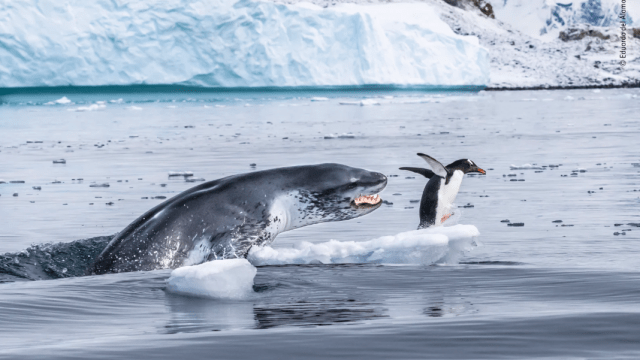The finalists have been announced for this year’s Wildlife Photographer of the Year competition. This year’s crop features some stunning ” and gut wrenching ” images. From animals fighting for their lives to the subtle beauty of a bird drinking from an icicle, these photographs are nothing short of remarkable.
The Wildlife Photographer of the Year competition, now in its 55th year, is managed by the Natural History Museum in London. This year’s contest included some 50,000 entries, which were submitted by both professional and amateur photographers from around the globe.
Overall winners will be announced on October 15, with judges basing their favourites according to “creativity, originality, technical excellence,” according to an NHM press release. A selection of highly commended images were released on Monday by the museum to whet our appetites.
This year’s crop showcases nature’s beauty, but also its intense brutality and fragility. In one image, a gentoo penguin flees for its life as a leopard seal attacks. In another, a lone cheetah ” surrounded by a pack of wild dogs ” lets out a roar in desperation. And in perhaps the most jarring image, a newborn hippo is the unlikely victim of a belligerent bull, as mum helplessly watches. Capturing lighter moods, the photos also show nature at its best, including an adorable raccoon in an abandoned car, a curious grey whale, and a tiny fish seeking refuge inside a jellyfish.
And like all great wildlife photography, these images serve as a potent reminder for us to take care of our natural environment. A poignant image of a dead sea turtle, choked by a wayward lawn chair, is among the most infuriating photos presented in this collection.
There has “never been a more important time for audiences all over the world to experience their work in our inspiring and impactful exhibition,” noted Tim Littlewood, the director of science at NHM and member of the judging panel, in a press release. “Photography has a unique ability to spark conversation, debate and even action. We hope this year’s exhibition will empower people to think differently about our planet and our critical role in its future.”
The above upsetting photo taken by Adrian Hirschi in Zimbabwe shows a male hippo crushing a days-old newborn, with the mother watching on in the background. A caption from NHM explains the grim scene:
He chased the mother, then seized the calf in his huge gape, clearly intent on killing it. After trying to drown it, he tried to crush it to death. All the while, the distraught mother looked on. Adrian’s fast reaction and fast exposure captured the shocking drama.
Infanticide among hippos is rare but may result from the stress caused through overcrowding when their day-resting pools dry out. A male may also increase his reproductive chances by killing young that are not his, triggering females to go into oestrus, ready to mate with him. Male hippos are also aggressively territorial, and brutal fights are not uncommon.
Indeed, the image is a stark reminder to steer clear of hippos. These fearsome herbivores are also known to attack humans.
A photo by Frank Deschandol shows a rather unfortunate weevil that was victimized by a parasitic zombie fungus. The NHM explains:
On a night-time fieldtrip in the Peruvian Amazon rainforest, Frank spotted this bizarre-looking weevil clinging to a fern stem. Its glazed eyes showed it was dead, and the three antennae-like projections growing out of its thorax were the ripe fruiting bodies of a “˜zombie fungus’.
Spreading inside the weevil while it was alive, the parasitic fungus had taken control of its muscles and compelled it to climb. When it was at a suitable height ” for the fungus ” the weevil held fast to the stem.
Fuelled by the weevil’s insides, the fungus then started to grow fruiting bodies topped by capsules that would release a multitude of tiny spores to infect new prey. Similar “˜zombie fungi’ are known to parasitize other insects.
The spores were released the following day and the fungus withered, completing the macabre cycle.
Photographer Jo-Anne McArthur submitted a photo showing rattlesnake skins pinned to a wall”a kind of trophy case for participants of the annual rattlesnake roundup in Sweetwater, Texas. The NHM explains:
Each year tens of thousands of rattlesnakes are caught for this four”‘day festival. In spring, wranglers use gasoline to flush the snakes out of their winter dens ” a practice banned in many US states. They are kept in poor conditions before being brought to the festival and tossed into snake pits.
They are then decapitated as entertainment for festival-goers, who pay to skin them. Proponents of the roundups claim they are needed to control the populations of venomous snakes to ensure the safety of people, pets and livestock. But opponents regard round-ups as an ecologically damaging, unsustainable and inhumane practice. What Jo-Anne found most unsettling about this image was “˜that so many of the bloodied handprints belonged to children’.
Yeah, not exactly the kind of message we should be conveying to our youth. Nature is truly paradoxical in its brutality and beauty, as this years best wildlife photos forcefully demonstrate.
